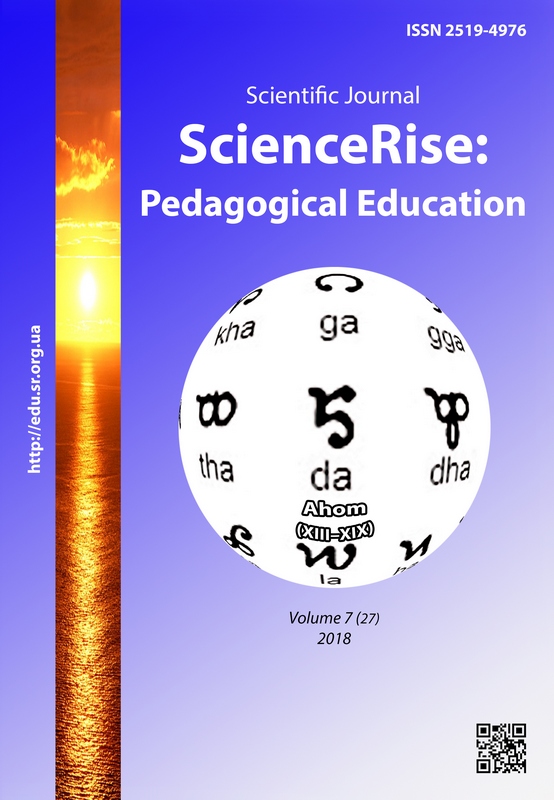Using interactive training technologies in the process of training future design teachers to professional self-development
DOI:
https://doi.org/10.15587/2519-4984.2018.151544Keywords:
іinteractive technologies, educational innovations, interactive training, professional self-development, professional activityAbstract
The article characterizes the essence and examples of using interactive training technologies in the process of training future design teachers to the professional self-development. It was determined, that the use of educational innovations in the process of formation of the readiness of future design teachers to the professional self-development provides the high level of the professional self-development of a teacher that is a necessary condition, means and criterion of formation of a professional in the training process.
The process of formation of the readiness of a future design teacher to the professional self-development has its unique specificity and is in the development of a person with creating thinking, intellect, professional independence, ability to destruct anything, already acknowledged as generally recognized, to accept flexible decisions in difficult life situations.
The practical aim of the future pedagogical activity is a support and strengthening of an interest to the chosen profession.
The use of innovative technologies in the educational process influence the active professional self-development of its subjects and is a development criterion of an educational institution, and the readiness to the activity develops, based on mastering general and professional knowledge, necessary for acquiring abilities and skills, improving formed professionally important qualities of a person, talents, important for the future professional ability of a teacher-designer. The use of interactive training technologies in the educational process needs from a teacher correspondent knowledge and skills for attaining correspondent results. Modern requirements to the quality of training of future teachers-designers need mainly innovative approaches in the educational process and high professionalism of teachers. Among pedagogical innovations, used in the process of training future design teachers to the professional self-development, an important place is occupied by active training forms and non-standard approaches to problems of the educational process.
The process of formation of the readiness of future design teachers to the professional self-development is inseparably connected with the use of educational innovations. Introduction of innovative training methods in the educational process provides the high level of the professional self-development of a future teacher
References
- Marinchenko, H. E., Komarchuk, A. A., Salyuk, O. Yu., Golub, V. O. (2018). Theoretical-methodological back-grounds of innovative educational under the condition of globalization and information revolution. Sciences of Europe, 3 (25), 33–36.
- Havryshchuk, I. V. (2016). Formation of production and technical orientation of the future employees my means of multimedia. Universum: Psychology and education, 1-2 (21). Avaialble at: http://7universum.com/ru/psy/archive/item/2927
- Komenskiy, Ya. A. (1982). Izbrannye pedagogicheskie sochineniya. Vol. 1-2. Moscow: Pedagogika, 656, 576.
- Vygotskiy, L. S. (1991). Pedagogicheskaya psikhologiya. Moscow, 389.
- Gal'perin, P. Ya. (1959). Razvitie issledovaniy po formirovaniyu umstvennykh deystviy. Psikhologicheskaya nauka v SSSR. Moscow: Prosveshhenie, 120.
- Kremen, V. H. (Ed.) (2008). Entsyklopediia osvity. Kyiv: Yurinkom Inter, 1040.
- Pidkasistyy, I. I. (1995). Pedagogika. Moscow: Rossiyskoe pedagogicheskoe agentstvo, 49–54.
- Pankov, D. V. (2006). Orhanizatsiia navchannia za interaktyvnymy tekhnolohiiamy. Donetsk: DIPO IPP, 46.
- Skrypnyk, M. (2005). Interaktyvne navchannia: osnovni poniattia. Ihry doroslykh. Interaktyvni metody navchannia. Kyiv: Biblioteka «Shkilnoho svitu», 30–43.
- Nychkalo, N. H. (Ed.) (2000). Profesiina osvita. Kyiv: Vyshcha shkola, 380.
- Milkova, R. (2015). Competency and Skills of the Person – Strategy of University Education during 21st Century. Strategies for Policy in Science and Education, 23 (1), 38–64.
Downloads
Published
How to Cite
Issue
Section
License
Copyright (c) 2018 Valentyna Malinkina

This work is licensed under a Creative Commons Attribution 4.0 International License.
Our journal abides by the Creative Commons CC BY copyright rights and permissions for open access journals.
Authors, who are published in this journal, agree to the following conditions:
1. The authors reserve the right to authorship of the work and pass the first publication right of this work to the journal under the terms of a Creative Commons CC BY, which allows others to freely distribute the published research with the obligatory reference to the authors of the original work and the first publication of the work in this journal.
2. The authors have the right to conclude separate supplement agreements that relate to non-exclusive work distribution in the form in which it has been published by the journal (for example, to upload the work to the online storage of the journal or publish it as part of a monograph), provided that the reference to the first publication of the work in this journal is included.








